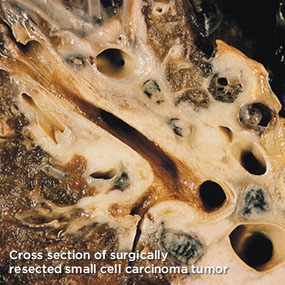Pathology

Image of lung tissue riddled with cancer
Content for pathology should be a review from your anatomy and physiology courses. You are expected to be able to describe diseases of the respiratory system and how they may be classified (e.g. obstructive, restrictive, etc.). Respiratory refers to the gas exchange; pulmonary refers specifically to the lung organ.
There is a succinct listing of respiratory diseases included in Pagliarulo COPD and restrictive lung diseases pages 244-245. Focus on your ability to:
- recognize, signs, symptoms and characteristics of respiratory disease
- define and differentiate pulmonary diseases.
You should be able to provide an example of each disease listed below under the appropriate category. Notice some diseases fall in more than one category such as pneumonia:
Obstructive disease
In general, this limits the efficiency and effectiveness of exhalation. It is difficult to expel CO2
Bronchial asthma or asthma
COPD
Chronic Obstructive Pulmonary Disease (COPD):
COPD describes a combination of two conditions
- Chronic bronchitis
- Inflammation of bronchial tissue, increased mucus production and cough
- Induced by bacterial, viral, or acute or chronic environmental exposure
- Emphysema
- A progressive thinning and degradation of the alveoli. Primary cause is smoking.
Restrictive disease
- Difficulty getting oxygen in
- Can be lung structure stiffness (scar tissue or protein deposits) that interferes with the lung's ability to expand, resulting in inefficient inhalation
- Can be due to muscle weakness in the chest wall, which limits effectiveness of inhalation
Common diagnosis and conditions that indicate restrictive disease are:
- Radiation Fibrosis: scarring of lungs from radiation
- Effects of quadriplegia such as from a spinal cord injury
- Acute respiratory distress syndrome (ARDS) A prevention of 02 getting into the lungs. Life threatening
- Infant respiratory distress syndrome: often a result of being born pre-mature: difficulty breathing due to small lungs
- Pneumonia
Here is a link on what is the cause of pneumonia
https://www.youtube.com/watch?v=yqwG-O3GR74
Infection
- Fluid accumulation in the lung space interferes with gas exchange
- Upper respiratory infection
- Tonsillitis
- Common cold
- Bronchitis
Pleural disease
- Mesothelioma: lung cancer
- Tension pneumothorax: often from a trauma such as an MVA, stabbing, or gun shot wound
- Empyema: pus in lungs
|
Classification |
Description |
Examples |
Signs and Symptoms |
Common Causes |
|
Obstructive |
Airway obstruction – difficulty moving air out of lungs |
COPD Emphysema Asthma Bronchitis Cystic fibrosis (CF) |
Productive cough Dyspnea |
Smoking Environmental particulates; allergies Genetic disorder (CF) |
|
Restrictive |
Increased lung stiffness/decreased compliance – infection or exposure resulting in scar tissue |
Asbestosis Respiratory Distress Syndromes |
Cough SOB |
Environmental exposure |
|
Infections |
Upper
Lower |
Cold Laryngitis Pneumonia Tuberculosis |
Sore throat, runny nose, sneezing |
Bacterial or Viral |
|
Pleural |
Collection of fluid in pleural cavity |
Pneumothorax Empyema |
Hypoxia Hypercapnia SOB Chest pain |
Trauma Acute or chronic infection Chronic lung disease |
Pulmonary Embolus
- A blood clot that prevents perfusion to lung tissue. Depending on the location within the blood vessel, this can be life threatening
- Sedentary lifestyle, pregnancy, smoking, birth control or other hormone therapies, cardiovascular disease, and recent surgery are all associated with increased risk for pulmonary embolus
- Treated with anticoagulants (blood thinners), thrombolytics (clot busters), and/or inferior vena cava filters
- Ankle pumps and compression stockings and intermittent compression devices are used to prevent blood clots
Lung Cancer
- Cancer is covered in depth in PTA 205
- 15% of lung cancer the West occurs in non-smokers (Subramanian & Govindan, 2007)
- Can result in combined restrictive and obstructive symptoms
Self Study
You can check your understanding of the diseases, their descriptions and classifications by linking to the
Self Study Activities.
Note only one disease per category for this activity, due to limitations of the formatting design of the self-study
References
Subramanian, J., & Govindan, R. (2007). Lung cancer in never smokers: a review. Journal of clinical oncology, 25(5), 561-570.

